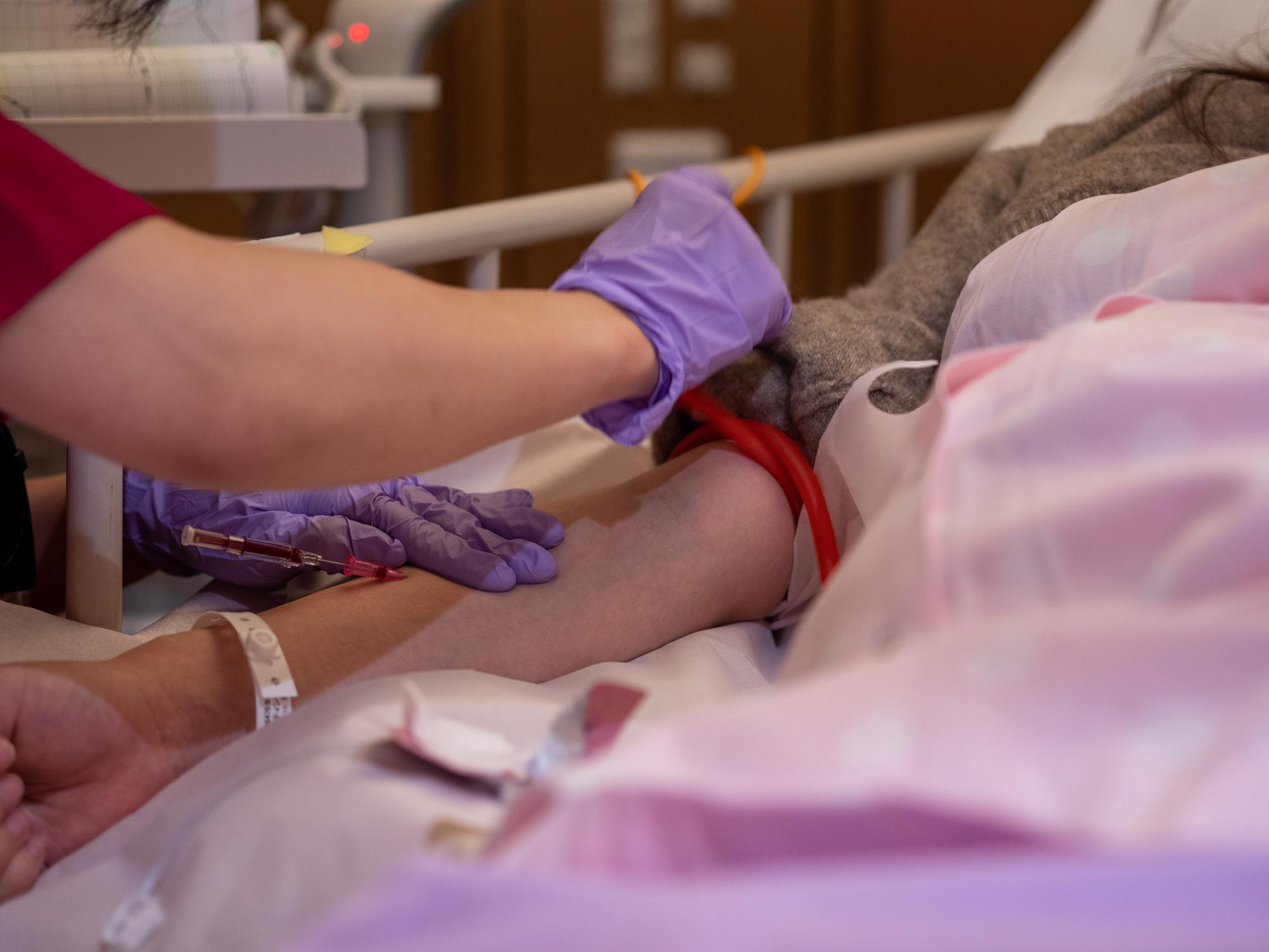Last Updated on November 26, 2025 by Bilal Hasdemir

Having port removal surgery can worry many patients. At Liv Hospital, we know how important a smooth recovery process is. After your surgery, the spot where your port was will have a dressing.
We suggest keeping the bandage on for 24 hours. This helps your skin heal properly.
During port removal recovery, you might feel some pain, swelling, or bruising. These symptoms usually go away in 1 to 2 weeks. Our team is here to offer compassionate care and help you through this time.
Key Takeaways
- Leave the bandage on for 24 hours after the procedure
- Expect mild to moderate pain, swelling, or bruising around the incision site
- Symptoms typically resolve within 1 to 2 weeks
- Follow proper aftercare instructions for a smooth recovery
- Our team is dedicated to providing compassionate care and guidance
Understanding Port Removal Surgery

Learning about port removal surgery can make you feel less anxious. It’s important to know what a port is and why it might be taken out.
A port is a small device put under the skin, usually in the chest. It’s made of materials like plastic or titanium. It has a thin tube called a catheter that goes into a vein. This device helps put medicines or treatments directly into your blood.
What is a Port and Why is it Removed?
Ports help with medical treatments by making it easier to give drugs or take blood. But, once treatment is done, the port is removed. This process, called port removal surgery, is simple.
Ports are removed for many reasons, like when treatment is finished, if there’s an infection, or if the port stops working. Knowing why your port is being removed helps you get ready for the surgery and recovery.
Types of Ports: Chemotherapy Ports, Mediports, and PICC Lines
There are different types of ports, like chemotherapy ports, Mediports, and PICC lines. They all have their own design, placement, and use.
- Chemotherapy Ports are under the skin for giving chemotherapy drugs.
- Mediports are also under the skin for giving medicines or chemotherapy.
- PICC lines, or Peripherally Inserted Central Catheters, are not fully under the skin. They are in a vein in the arm.
Knowing the type of port you have and why it’s being removed helps you prepare for port removal surgery and recovery. Each port has its own removal method and care needs. Your doctor will tell you all about it.
Preparing for Your Port Removal Procedure

Getting ready for port removal surgery is key. It involves following certain steps before the surgery. We know it can feel scary, but being prepared makes it easier.
Pre-Surgery Instructions
Following our pre-surgery advice is important. It helps make the procedure go smoothly. Here are some things to do:
- Don’t eat or drink anything for a certain time before, as your doctor will tell you.
- Stop taking certain medicines that might mess with the surgery or your healing.
- Tell us about any allergies or health issues that could change your treatment.
Also, make sure someone can drive you home after. You might be feeling the effects of anesthesia or pain meds.
What to Bring to Your Appointment
On the day of your surgery, bring:
- Your ID and insurance details.
- A list of your current medicines and how much you take.
- Any medical records or test results that are important.
- Wear comfy clothes that make it easy to get to the port site.
Having these things ready makes things go faster and helps us get what we need.
Setting Realistic Expectations
Knowing what to expect after surgery helps you get ready. You can go back to eating normally after. But, don’t lift anything over 10 pounds for 3 days to stay safe.
By following these tips and knowing what happens during your surgery, you can avoid problems. And you’ll have an easier recovery. If you have questions or worries, talk to your doctor.
The Port Removal Process: What Happens During Surgery
Understanding port removal surgery can make patients feel more comfortable. We’ll explain the steps, anesthesia options, and what to expect before and after surgery.
Step-by-Step Procedure Overview
The port removal process includes several steps:
- Preparation, which may include cleaning and disinfecting the skin over the port.
- Administration of anesthesia to numb the area.
- A small incision is made over the port to access it.
- The port is carefully dissected from the surrounding tissue.
- The catheter associated with the port is removed.
- The incision site is closed, usually with sutures or staples.
Anesthesia Options and What to Expect
Anesthesia is key to a comfortable port removal procedure. There are different types:
- Local Anesthesia: This numbs the area around the port, keeping the patient awake.
- Conscious Sedation: This helps patients relax during the procedure.
If local anesthesia is used, the area may be numb for a few hours.”Local anesthesia is effective in managing pain during port removal, ensuring a relatively painless experience for the patient.”
Duration and Immediate Post-Procedure Care
The procedure is quick, lasting about 30 to 60 minutes. Afterward, patients are monitored in a recovery area.
Immediate care includes:
- Monitoring for any immediate complications.
- Managing pain, which is usually mild.
- Providing instructions on wound care and follow-up.
Following these instructions is key for a smooth recovery. Some discomfort is normal, but it’s usually manageable with over-the-counter pain medication.
Port Removal Recovery: The First 48 Hours
The first 48 hours after port removal surgery are key for a good recovery. It’s important to manage pain, care for your wound, and know what activities to avoid. By following these steps, you can avoid complications and recover well.
Managing Pain and Discomfort
Managing pain well in the first 48 hours is essential. Always follow your doctor’s advice on pain meds. You might feel some pain, swelling, or bruising at the incision site. Here’s how to handle it:
- Take pain medication as directed by your healthcare provider
- Apply ice packs to reduce swelling (if recommended by your healthcare provider)
- Rest in a comfortable position, avoiding pressure on the incision site
Wound Care Essentials
Good wound care is key to avoid infection and help it heal. Keep the bandage on for 24 hours after surgery. After removing it, clean the area with mild soap and water. Remember to:
- Keep the incision site clean and dry
- Avoid submerging the incision in water (such as taking a bath or swimming) until your healthcare provider advises it’s safe
- Pat the area dry with a clean towel
If you have sutures, Steri Strips™, or Dermabond®, follow your healthcare provider’s specific instructions for care and removal.
Activity Restrictions
Knowing what activities to avoid is important for a safe recovery. We suggest:
- Avoiding heavy lifting, bending, or strenuous activities for at least 48 hours
- Taking regular rest periods to avoid fatigue
- Gradually resuming normal activities as advised by your healthcare provider
When to Contact Your Healthcare Provider
It’s important to know when to call your doctor during recovery. Call them right away if you notice:
- Increasing pain or swelling
- Redness or warmth around the incision site
- Fever or chills
- Drainage or bleeding from the incision site
- Any other concerning symptoms
Being aware of these signs and following your doctor’s advice can help you recover smoothly from port removal surgery.
10 Essential Tips for Optimal Port Removal Recovery
The time after port removal surgery is very important. It needs careful handling to avoid problems. A good recovery depends on following certain rules for wound care, pain control, and post-surgery care. Here are 10 key tips to help you through this important phase.
Tip 1: Keep the Incision Site Clean and Dry
Keeping the incision area clean is key to avoid infection. Wash the area gently with soap and water, and make sure to rinse well. After showering, dry your skin with a soft, clean towel. You don’t need to cover it again unless your doctor says so.
Tip 2: Follow Pain Medication Instructions Carefully
Managing pain is a big part of getting better. Stick to the pain medication plan your doctor gives you. This ensures you take the right amount at the right time. It helps control your pain without overdoing it.
Tip 3: Sleep on the Opposite Side of Your Incision
Sleeping on the other side of your incision can make you feel better and help it heal. This way, you put less pressure on the wound, which helps it heal faster.
Tip 4: Use Ice Packs to Reduce Swelling
Using ice packs on the area can lessen swelling. Wrap the ice pack in a cloth to protect your skin, and use it for the suggested time. This simple trick can really help.
- Watch your wound for signs of infection, like redness, swelling, or discharge.
- Eat a balanced diet full of nutrients to help your body heal.
- Drink lots of water to stay hydrated.
- Avoid hard activities as your doctor advises.
- Go to follow-up appointments to check on your healing.
| Recovery Tip | Benefit |
| Keep incision site clean and dry | Prevents infection |
| Follow pain medication instructions | Manages pain effectively |
| Sleep on opposite side of incision | Reduces discomfort and promotes healing |
| Use ice packs | Reduces swelling |
By following these 10 essential tips, you can greatly improve your recovery from port removal surgery. Remember, your healthcare provider is your best guide for personalized advice and care.
Port Removal Surgery Recovery Timeline
Knowing the recovery timeline after port removal surgery is key for a smooth healing. The recovery has several stages, each with its own milestones.
Days 1-3: Initial Healing Phase
The first three days after surgery are critical. The body starts to heal the wound. Patients might feel some pain, swelling, and bruising. Following post-operative instructions carefully is important to avoid complications. A patient shared, “Resting and following the doctor’s orders made a huge difference in my recovery.”
Days 4-14: Progressive Healing
From days 4 to 14, healing gets better. The wound starts to close, and pain lessens. Patients can start doing normal things again, but should avoid hard tasks. Keeping the incision site clean and dry is key during this time.
“The first two weeks were critical. I had to be gentle with myself and not overexert. It really helped my body heal faster.” – Recovery testimonial
Weeks 2-6: Return to Normal Activities
By weeks 2-6, most can go back to work and exercise with doctor’s approval. The scar will keep healing and may change in look. Using scar care techniques can help the scar look better.
Long-term Healing and Scar Formation
Healing and scar formation can last more than six weeks. Scars might stay sensitive or visible for months. Gently massaging the scar can make it look better and feel less sensitive. Doctors say, “Full recovery and best scar healing can take up to a year, but it varies.”
Understanding the recovery stages helps patients prepare for healing after port removal surgery. Always follow your healthcare provider’s advice, as everyone heals differently.
Potential Complications and How to Address Them
Knowing about port removal complications helps patients prepare for recovery. Port removal surgery is usually safe. But, it’s important to know about possible issues and how to handle them.
Common Side Effects vs. Serious Complications
After surgery, patients might feel mild pain, swelling, or bruising. These are usually short-term and can be managed with care. But, it’s key to tell the difference between these and serious problems that need medical help.
Serious complications include infection, hematoma, or severe bleeding. Spotting these early can make treatment more effective.
Recognizing Signs of Infection
Infection is a possible issue after port removal. Look out for:
- Redness or swelling around the incision that gets worse
- Discharge or bleeding from the wound
- Fever over 100.4 °F (38.0 °C)
- Pain that doesn’t get better with medicine
If you see these signs, call your doctor right away.
Managing Hematoma After Port Removal
A hematoma is when blood collects at the port removal site. Symptoms include swelling, pain, or bruising. To manage it, use ice packs and follow your doctor’s care instructions.
In some cases, a hematoma might need to be drained. Keep an eye on its size and tell your doctor about any changes.
Chemo Port Removal Side Effects
Those who had chemo through a port might face specific side effects after removal. These include:
- Prolonged bleeding or bruising
- Higher risk of infection due to weakened immune system
- Potential for hematoma because of how chemo affects blood clotting
It’s important for these patients to follow their doctor’s advice closely to reduce these risks.
By understanding these complications and how to deal with them, patients can better handle their recovery.
Special Considerations for Different Port Types
The type of port you’ve had implanted can affect your recovery. Each port has its own needs for removal and care.
Chemotherapy Port Removal Recovery
Chemotherapy ports are used for a long time. Their removal needs careful planning. It’s important to follow specific care instructions after surgery.
- Keep the incision site clean and dry to prevent infection.
- Avoid heavy lifting or bending, as these activities can strain the wound.
- Follow your healthcare provider’s instructions for pain management.
Recovery Timeline: Most patients can go back to normal activities in 1-2 weeks. But, always listen to your doctor’s advice on activity levels and follow-up care.
PICC Line Removal Aftercare and Healing Time
PICC lines are similar to ports but not technically a “port.” They need careful removal and aftercare.
After PICC line removal, do the following:
- Apply pressure to the removal site for a few minutes to minimize bleeding.
- Keep the site clean and dry for 24-48 hours.
- Monitor for signs of infection, such as redness, swelling, or fever.
Healing Time: The site usually heals in a few days. But, always follow your healthcare provider’s advice on aftercare and activity restrictions.
Mediport Removal: Specific Recovery Guidelines
Mediports are implanted under the skin. Their removal is a minor surgery. Recovery guidelines are similar to chemotherapy ports.
Key considerations include:
- Avoiding strenuous activities that may pull on the incision site.
- Following your doctor’s instructions for wound care and dressing changes.
- Managing pain effectively through medication and other recommended methods.
Activity Restrictions: Avoid arm and upper body movements that may pull on the incision for the first week. This includes heavy weight lifting (no more than 4.5 kg or 10 lbs.) and vigorous use of your arms.
Understanding your port’s specific needs can help you recover smoothly.
Conclusion
A successful port removal recovery needs careful attention to wound care, pain management, and activity limits. By following the essential tips and guidelines, you can lower the risk of complications. This helps in a smooth recovery.
Good port removal aftercare is key in the days and weeks after surgery. We talked about keeping the incision site clean and dry, managing pain, and avoiding hard activities. Following these tips helps ensure a successful recovery and lowers the risk of complications.
As you recover, stay informed and proactive. If you have concerns or questions, reach out to your healthcare provider. With the right care and support, you can confidently navigate the recovery process.
FAQ
What is the typical recovery time for port removal surgery?
Recovery time for port removal surgery varies. Most people can get back to normal in a few days to a week. But, it might take weeks for the body to fully heal.
How do I care for my wound after port removal surgery?
Keep the wound clean and dry. Follow your doctor’s advice for dressing changes. Watch for signs of infection like redness or swelling.
What are the common side effects of port removal surgery?
You might feel pain, swelling, or bruising at the site. Some people get numbness or tingling.
How can I manage pain after port removal surgery?
Use pain meds as your doctor suggests. Ice packs can help with swelling. Resting and avoiding hard activities also helps.
What are the signs of infection after port removal surgery?
Look out for redness, swelling, or warmth at the site. Fever, chills, or pus are also signs. Contact your doctor if you see these.
How long does it take for the scar to heal after port removal surgery?
Scar healing time varies. It usually takes weeks to months for the scar to fade.
Can I shower after port removal surgery?
You can shower, but follow your doctor’s wound care advice. Avoid getting the site wet until it’s fully healed.
What are the specific recovery guidelines for Mediport removal?
Recovery for Mediport removal is similar to other ports. Keep the site clean, manage pain, and avoid hard activities. Your doctor may give specific advice.
How do I manage hematoma after port removal?
Use ice packs and elevate the limb. Follow your doctor’s pain management and follow-up advice.
Are there any specific considerations for chemotherapy port removal recovery?
Chemotherapy port removal recovery needs careful wound care and pain management. Your doctor will guide you on managing chemotherapy side effects.
What is the healing time for PICC line removal?
PICC line removal healing is usually quick. Most people feel little discomfort and heal fast. But, follow your doctor’s aftercare advice.
Reference :
- National Health Service (NHS). (2024). Central line and cannula removal. https://www.uhb.nhs.uk/leaflet/central-line-and-cannula-removal/






